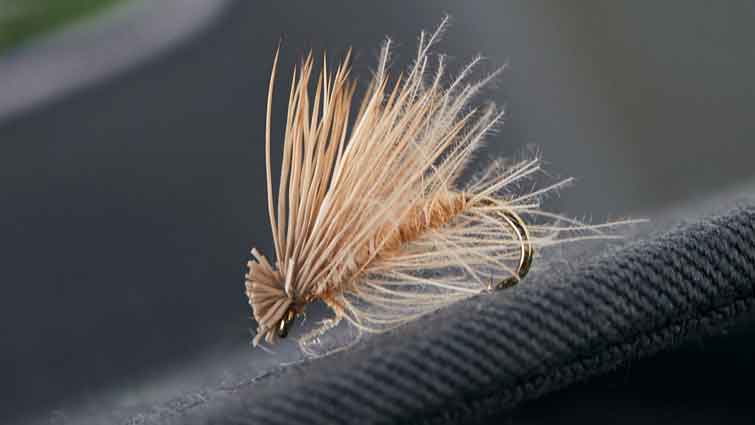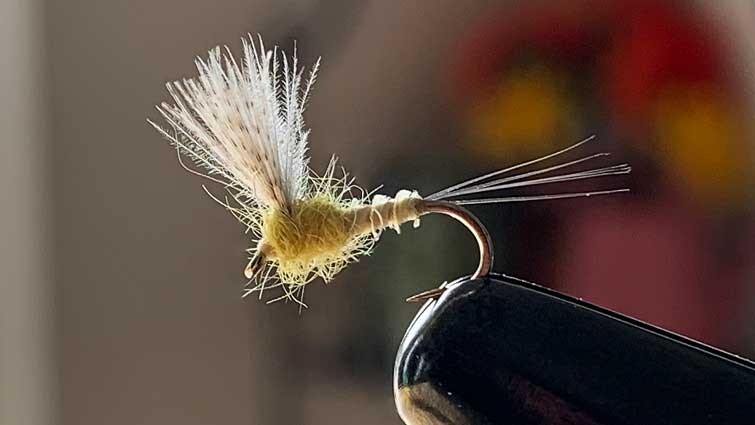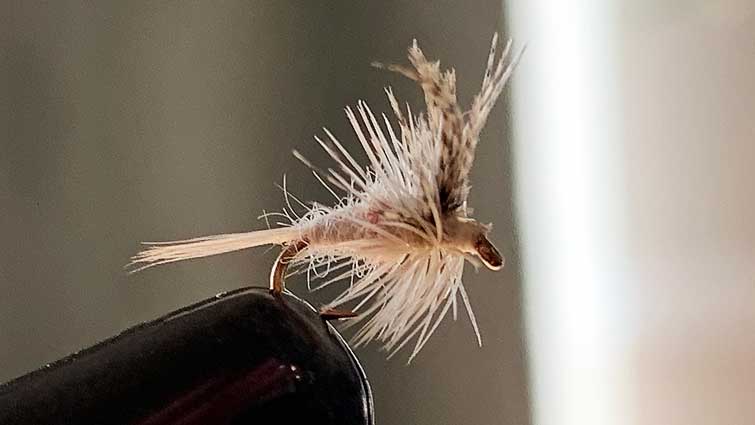The best size dry fly for trout is different depending on where you are fishing, when you are fishing, what type of water conditions you are in, etc. To name a few factors that will affect the best size dry fly for trout, you will have to consider the time of year, time of day, water conditions, clarity/type of water, how fast or slow the current is moving in the water you are fishing, what kind of weather it is.
As a general rule, the best size dry fly for trout is generally sized 12-18. If you are fishing at night for larger trout, the best dry fly for visibility is usually more prominent in sizes 6-10. Smaller patterns are often used when you are precisely matching the hatch. When it comes to trout, medium-sized dry flies tend to be the top choice.
The best size dry fly for trout will always depend on where and when you are fishing. In this article, the best size dry fly for trout is explained based on where you are fishing, what type of water conditions are in that particular area, and at what time.

What Sized Dry Fly Should I Use for Trout?
As mentioned before, the best size dry fly for trout will change depending on fishing. What time of year helps to determine if you should be using a smaller or bigger-sized fly. Above all else, matching the hatch of the season will give you the best results for catching trout.
When it comes to the color and size of the fly to use, there is no hard and fast rule when it comes to trout; therefore, utilize patterns with many hues so you may replicate all of the various life stages in their diet and sizes between 12-18 will cover most situations.
Trout have a highly developed sense of sight, especially regarding movement, making brightly colored flies a productive choice. Flies tied with feathers work well because they look a lot like many insects that trout eat.

The Best Color of Dry Flies for Trout Fishing
Dry flies should be size 16-12. The Adams is a top dry fly choice for most trout species. Other suitable options include Elk Caddis, Stimulator (black), or Parachute Adams.
Black and brown are standard colors here as well. Try black, dark olive, and brown for these patterns. For trout, dry flies are best fished on the water's surface.
To fish dry flies successfully, you need fish either feeding on the surface or gazing up for food. The optimum moment to fish a dry fly is during the hatch when the fish are paying close attention to the surface, and emerging insects or falling insects enter the water.

The Best Dry Fly Mayflies
Mayflies are a big part of any trout stream. Some trout are sight feeders, but most take their food from the surface or after it descends below them to ensure it isn't a threat. The best dry fly insect for trout is the emerging mayfly because they are doing precisely what trout want them to do - leaving the water's surface.
This is one of the most accessible insects for beginning anglers to fish with a dry fly because they are plentiful and easy to imitate. Once you have caught your first fish on an emerged, you will know why so many people use this pattern so often when fishing for trout, especially browns and brookies in the Eastern United States.

Parachute Adams
The parachute Adams is probably one of the most versatile dry flies for trout that you can choose. It typically will work well in any type of water condition and represents everything from mayflies, midges, terrestrials, black ants (in the fall) - pretty much anything! If I had to pick one fly (that's not a spinner pattern), this would definitely be the one I'd go with because it will be effective no matter what species of trout you're trying to catch or what time of year it is.

Comparadun PMD
The Comparadun is typically a size 14 or 16 dry flies, making it smaller than an Elk Hair Caddis but technically classified as a larger-sized dry fly because of the wing and hackle combo on this pattern. I usually use Comparaduns around areas where there might be some type of emerger hatching around.

Pale Morning Dun
The Gold Ribbed Hare's, Ear Nymph, or Pheasant Tail Nymph is a fantastic PMD nymph imitation. In areas with a lot of fishing pressure, such as rivers where the water surface is broken, you may notice the trout becoming more cautious and eating only drifting nymphs while anything on the surface goes unnoticed.

Best Dry Fly Caddis
Caddisflies are one of the most common flies that trout feed on. They account for more than 50 percent of a trout's diet in some areas. Caddis live in freshwater from spring until fall and spend their larval stage underwater.
To help them get oxygen, caddis build nets of silk that hang down from the surface of the water until they emerge as a winged adult or climb onto a rock or plant stem and shed their nymphal skin - often referred to as "dressing."
Imitating caddisfly adults can be tricky because there are many different species with many different colors and patterns. If you're not sure what type is around, try to use something that looks like it would fit the current water conditions.

Elk Hair Caddis
Elk hair caddises do well anytime mayflies are hatching around your area. If you're looking to fish a larger-sized dry fly, this is the route to take because they are quite popular among trout fishermen after bigger fish. If you can manage to cast them accurately and get them to stick within arm's reach of the trout, then you'll find these are very effective.

Goddard Caddis
This is the caddis pattern to use when you want to fish an emerger dropper trailing behind. This fly is made of a carefully trimmed deer hair caddis body that has excellent buoyancy and receives a lot of takes.

Best Dry Fly Midges
Midges are a significant food source for many species of trout, especially grayling and char in Northern Europe. In North America, midges usually become necessary during the spring and fall months.
The most popular patterns used to imitate midget patterns are the Griffith's Gnat and the Pheasant Tail Nymphs, both of which come in size 20. These insects live underwater as larvae until they emerge when water temperatures reach about 50 degrees when it is safe for them to climb onto plants or rocks where they can hatch into adults that can be seen on the surface.

CDC Midge Pupa
Midge nymphs are available all year. They're a must-have for any trout food pantry. They hatch year-round and are pretty standard. Depending on the conditions, this fly may be fished either as an emerger or a dead drift nymph.

Crystal Midge
Midge fish appear on the surface every year on average. Midges are a nutrient-dense food source that can be found all year round. This design is a fantastic imitation and features translucent peacock and glitter to catch the eye. Crystal Midge has lots of flash and a bubble to pique interest. It can be floated or used as a nymph. Both are extremely effective

Best Dry Fly Hoppers
Hoppers are usually found near banks or around rocks where they can climb up to have a quick meal of algae and other plant life before plunging back into the water.

Half Chernobyl
The Half Chernobyl is a modern take on an old classic. This fly is very easy to tie and only takes about 10 minutes which makes it suitable to go whether you're on the water or not! Another great thing about these flies is that they are essentially universal, meaning they will work for any type of fish species under the sun - bass, trout, salmon; pick your poison!

Fat Albert
The Fat Albert is a great fly in the early spring and fall months when giant bugs like cicadas and hoppers are in season. If you're in an area where there aren't hatches of any insects, then this is a fly that can still catch fish because it's so well-known by trout fishermen.

What Size Flies Are Best for Trout?
Above all, match the hatch. Be aware of what is typically hatching at the time, and make sure to bring a variety of nymphs and dry flies with you on your fishing trip. Size green, brown, and black fly patterns for low visibility and bright colors if the water is clear. Make sure that your flies are tied correctly so they can do their job properly.
The best flies for brown trout include Dry flies 12-16, wet flies 12-16, streamers 4-6, ideally. You may get by with others at times, but you should have a range of sizes and colors in your box to handle all possibilities.
Because sizes 12-18 are ideal, nymphs in this range are best. It's difficult to top a tiny Adams in sizes 20-24 when midges emerge. (It's difficult to tie in wings that small therefore skip them from the pattern when making flies in these small sizes.)
How Do I Choose the Right Size Fly?
First, give the water a close inspection to choose the right fly. Second, tie on an imitation that looks like the most likely food supply if you see feeding fish. Third, if there aren't any feeding fish to be seen, try using an attractor that suggests a bug or baitfish typical to the region.
When choosing a fly for trout, matching the hatch is always essential, so bring along a variety of nymphs that match up with what may be hatching at any given time during your day on the river or lake.
The larger the number, the smaller the fly. Most nymphs and dry flies in sizes 16 to 12 are utilized, although size 20 or 22 dry flies are occasionally employed. Streamers in sizes 6 to 4 are often used.

How Big Is a Size Six Fly?
The size of the hook on which the fly is tied is referred to by a number that indicates the size of the hook. The larger the number, the smaller the fly. A size 18 Adams (#18 Adams) is smaller than a size 12 Adams (size 12).
|
Hook Size |
Inches |
Fly Size |
|
#2 - #4 |
7/16” |
X-LARGE |
|
#6 - #8 |
3/8” |
LARGE |
|
#8 - #10 |
1/4” |
LARGE |
|
#10 - #12 |
5/32” |
MEDIUM |
The best dry flies for trout will not only work once, but they'll be effective multiple times throughout the season, depending on what hatches around your area. All you need to do is keep learning about insect life cycles and variations within species and pick the right time to target specific types of fish.
When it comes to trout, size seems to matter. Medium-sized dry flies usually work best, and you can experiment with different colors of these medium-sized flies for the time of day or type of fish you're targeting. If you're ever unsure about what kind of fly to use, be sure you're matching the hatch of the season and environment.




